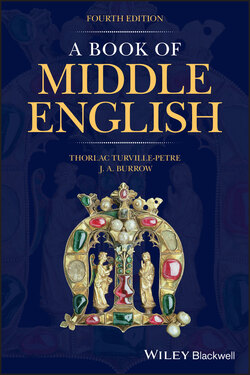Читать книгу A Book of Middle English - J. A. Burrow - Страница 19
2.2 Vowels 2.2.1 The Long Vowels
ОглавлениеThe main system of long vowel sounds in Middle English was as follows (a colon indicates length):
| /a:/ | as in modern ‘father’ |
| /ε:/ | as in French ‘bête’ (‘open e’, roughly as in modern ‘there’) |
| /e:/ | as in French ‘thé’ (‘close e’, roughly as in modern ‘say’) |
| /i:/ | as in modern ‘see’ |
| /ɔ:/ | roughly as in modern ‘broad’ (‘open o’) |
| /o:/ | as in French ‘eau’ (‘close o’, roughly as in modern ‘go’) |
| /u:/ | as in modern ‘do’ |
The following Middle English words illustrate typical ways of representing these sounds:
save and caas (modern ‘case’) have /a:/
lene, heeth and death commonly have /ε:/
nede and sweete have /e:/
fine and shyne have /i:/
holy and oon (modern ‘one’) have /ɔ:/
foot and mone (modern ‘moon’) have /o:/
hous and lowde have /u:/
Three observations may be added. The long open e, /ε:/, was unstable: words such as lene commonly have variants with the long close vowel, /e:/. Secondly, neither the distinction between open and close long e nor that between open and close long o is regularly marked by Middle English spelling. Modern spellings are a better guide, in cases where the word survives. Thus ‐ee‐ and ‐oo‐ in modern words (e.g. ‘feet’, ‘moon’) frequently indicate a close vowel in the Middle English word. Similarly, ‐ea‐ and ‐oa‐ in modern words (e.g. ‘heath’, ‘boat’) frequently indicate earlier open vowels. Finally, it should be noted that two of our early texts, nos 1 and 3, employ the Old English vowel symbol æ (known as ‘ash’), most often for /ε:/, but also for /a:/.
It will be seen that in Middle English spellings the letters a, e, i, o, and u, when they represent long vowels, have values very different from those in Modern English. But it is Modern English which is out of line here. Middle English scribes followed Latin usage (going back to the time when Anglo‐Saxon was first written in the Latin alphabet) and also, to a lesser extent, French. This is the usage which still prevails in the writing of French and other continental languages. English is now ‘out of line’ as a result of a series of changes which affected all the English sounds in question during the fifteenth, sixteenth and seventeenth centuries: the so‐called Great Vowel Shift. Thus, Middle English /a:/ shifted to /e:/; but the words in which it occurred (‘case’, ‘name’ etc.) preserved their old a spelling. Similar changes affected the sounds but not the spellings of the other Middle English long vowels. So, by the eighteenth century:
| /a:/ | became /e:/ and later the diphthong /ei/ (modern ‘name’) |
| /ε:/ | became either /e:/ (modern ‘break’) or more often /i:/ (modern ‘heath’) |
| /e:/ | became /i:/ (modern ‘see’) |
| /i:/ | became the diphthong /ai/ (modern ‘time’) |
| /ɔ:/ | became /o:/ (modern ‘boat’) |
| /o:/ | became /u:/ (modern ‘moon’) |
| /u:/ | became the diphthong /au/ (modern ‘house’) |
